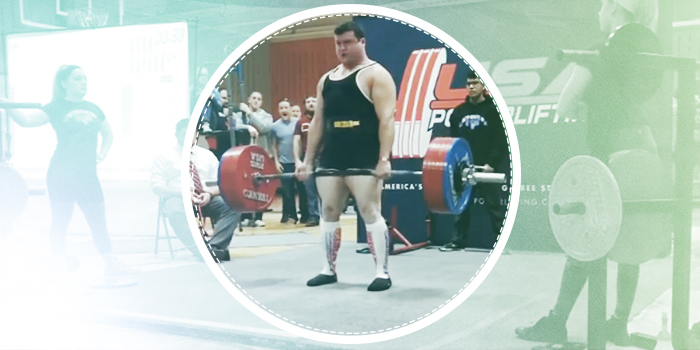
Just how every drug-addicted stripper is en route to a doctorate in psychology, everyone that sets foot on the powerlifting platform can set a world record, assuming they find the right platform.
When I talk about clients setting world records, I mean real world records. This past weekend, Matt Sohmer set two unofficial IPF world records in the squat and in the deadlift raw as a junior (23 years and under), weighing 256 pounds. He squatted 821 pounds raw and deadlifted 805 pounds.
I’m very proud of Matt! He is an amazing young man on and off the platform. Matt’s focus and work ethic at such a young age is unparalleled.
Video of Matt’s Record-Breaking Lifts with Commentary
Matt’s bench press has also improved quite a bit, but today we are going to focus on strategies that helped Matt shatter his already 804 squat and 771 deadlift.
Overload in the Squat Suit
Growing up as an athlete, I remember sometimes asking coaches why things were done a certain way. The great coaches who I respected always gave thoughtful answers and let me know that their way was constantly evolving. The derelicts that were more concerned with job security and kissing the boss man’s ass would mutter, “We’ve just always done it that way.” The reality is, these dudes had no clue and were more confused than Ray Charles with a "Where’s Waldo?" book.
Bottom line: all that matters is results. You are either creating or you are disintegrating. If this requires breaking from orthodoxy, so be it.
I consistently train raw bench press world record holders with Slingshots, why wouldn’t the same concept in the squat work with a squat suit? It did, and offered a huge boost physiologically and psychologically to Matt.
Application Point
The heaviest Matt went up to in the squat suit is 900, so that is about 10-percent over what he squatted. You don’t need to get a squat suit that adds 300 pounds; just get one that adds 10-percent or so and lets you hit depth. If you don’t want to invest in a suit, give briefs a shot. You squat raw with no wraps? Great, try adding wraps sometimes. The squat suit overload is not about hitting a certain number; it’s an overload tool to serve you. What you squat in a suit in training means jack squat — the platform means everything.
Frequency
How often you should perform a lift in training is one of the most heated debates in contemporary powerlifting. There are people that are smart and strong on both sides of the fence. This is the issue — being on one side of the fence.
RECENT: Mighty Joe Bradley: Best Pound-for-Pound Lifter of All-Time
This should never be about subscribing to some sort of dogma. This is about what works best for an individual, not about “proving” your system that you are trying to sell. This is why I have never sold one particular system in my books; I have many programs because I admit this is constant evolution and all I care about is results.
Matt did very well with a higher frequency approach; he squatted or did some variation of squats four times a week. He deadlifted only once a week. Both lifts set unofficial IPF world records. The objective was RESULTS. If that meant dressing up like a clown and juggling shot puts, that is what Matt would have done.
Application Point
Like Frank Sinatra, you gotta find your way! Generally, the more upright Olympic-style squatter can get away with more frequency than the traditional, low-bar, more bent-over power squatters. Some great squatters have squatted daily, and others have set world records squatting twice a month. A good start point is one to two days a week, then experimenting from there. Obviously, all things being equal, less is better. Find your way.
More Upper Back Training
Every training session Matt hit his upper back. By increasing Matt’s upper back strength, his deadlift, particularly his lockout, has improved, squats feel lighter on his back, and the one lift that Matt has always dreaded—the bench press—has gone from piss poor to now below average, on its way to average and beyond.
Kaz was right; a strong back equals a strong man.
Application Point
While everybody’s recovery abilities are different, dollars to donuts says most people could get away with a hell of lot more upper back training volume and frequency. The upper back recovers quickly; the lower back recovers not so quickly. So to start adding more upper back work in your program, avoid excessive bent-over rows and T-bar prison rows. Do your rows chest supported, do pull-ups, lat pulldowns and, hell, even some of the machines at your local chrome palace commercial gym can be useful.
Lifestyle Factors
In the middle of past training cycles, Matt would just announce he was going on a cruise or taking a vacation. That’s all fine and dandy if you are training to lower your blood pressure or calm your nerves, but if you want to be an ass-kicking, son-of-a-buck on the platform, that won’t cut the mustard. The last two training cycles Matt has planned recreational activities around training and competitions like great champions do.
Application Point
Tequila, Tejano, and señoritas on warm Tijuana nights aren’t the way to lifting world records on the powerlifting platform.
My mentor, Dr. Fred Hatfield, constantly referred to himself in his powerlifting prime as a priest, and the iron was his monastery. What he means is he had Zen-like focus operating in the zone out of pure love and abundance — love for the process of getting stronger, and abundance in believing in the possibility of what pundits consider impossibility. If you want to be the best, get focused and realize this is a lifestyle and you must operate in the zone.
Implement Dead Squats
Dead squats, Anderson squats, concentric-only squats, or whatever the hell else you want to call them helped Matt. Doing these two inches above parallel helped Matt’s deadlift immeasurably; they also catapulted Matt’s squat. This helped Matt build a ton of power out of the bottom of the squat. In the past, Matt always came out of the hole quickly and then a couple inches above parallel, where the elastic-like energy from the negative portion of the lift wore off (stretch-shortening cycle), Matt would stall out.
Building power in this position did more than prevent him from stalling out. It was like inserting a rocket in his rectum — he powered right through that point.
Application Point
Only perform dead squats for singles. Doing multiple repetitions introduces the stretch-shortening cycle, which we want to eliminate. Shorter lifters will want to do these about an inch above parallel and taller lifters more like three to four inches above parallel. For deadlifts you can lessen the range of motion and take a stance that mimics your deadlift stance. If you have an SS Yoke Bar, use it!
Final Thoughts
I am very proud of Matt! Since we have already mentioned Frank Sinatra, let’s conclude with him. In the words of old blue eyes, “The best is yet to come." You ain’t seen nothing yet when it comes to Matt Sohmer!











He stopped qualifying as a Junior as of the 1st of Jan 2017, before he pulled 805.
Typo? Or are you artificially trying to inflate credentials for yourself and one of your athletes?
Matt is 23 years old.
Extract from the IPF rulebook:
"Junior: from 1 January in the calendar year he reaches 19 years and throughout the full calendar year in which
he reaches 23 years."
For the layman: You stop being a junior at the end of the year you turn 23.
Not a minor oversight at all. But if you don't accept it, you diminish his actual accomplishments with your fradulent use them.
So basically you think myself and Elitefts are liars and perpetuating some sort of "fake news" self interest conspiracy.....................
I would go read the rule book but I have to many other all-time world record holders that need my attention.
Have a nice day and stay happy!
Unoffical simply means it wasn't a sanctioned international meet, not that you can declare whatever you feel like contrary to the rules to try and claim something you have no entitlement to.
Not diminishing? How about people out there, you know, who actually hold an Unofficial World Record - legitimately?
i don't think it's 'fake news'. It is however fradulent behaviour for the purpose of artificially inflating your credentials.
Amateur hour up in here.
In every other federation (unless I am mistaken) 20-23 is a junior........so there was no attempt at fraud just one to share info with our readers (actually help people get stronger) and promotion of one of my athletes
Have a nice night & God bless!
I was unaware of the rule change but makes sense as they have changed weight classes and such--my goal was to convey the readers with helpful info and from the emails I have received and your comment it sounds like mission accomplished!